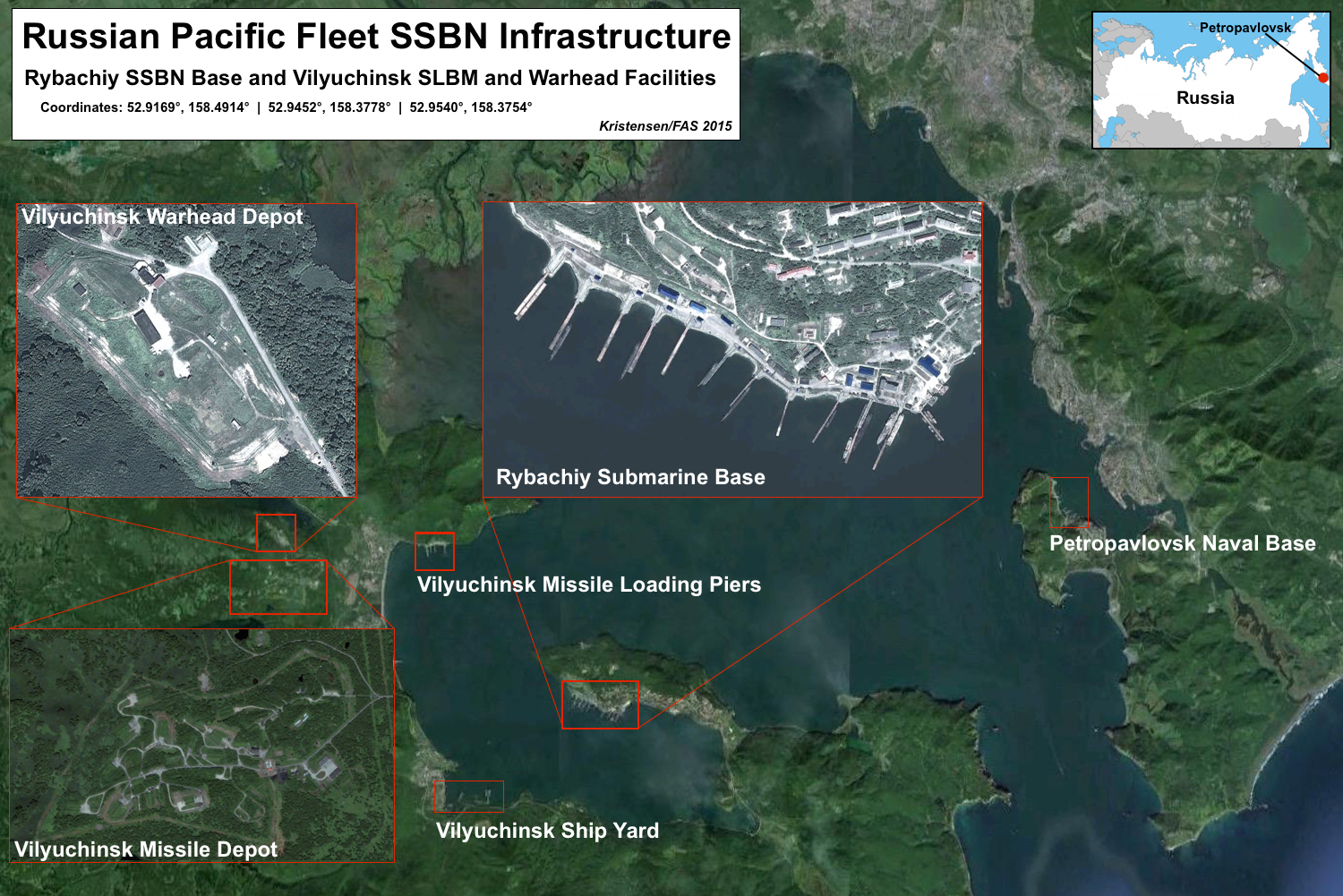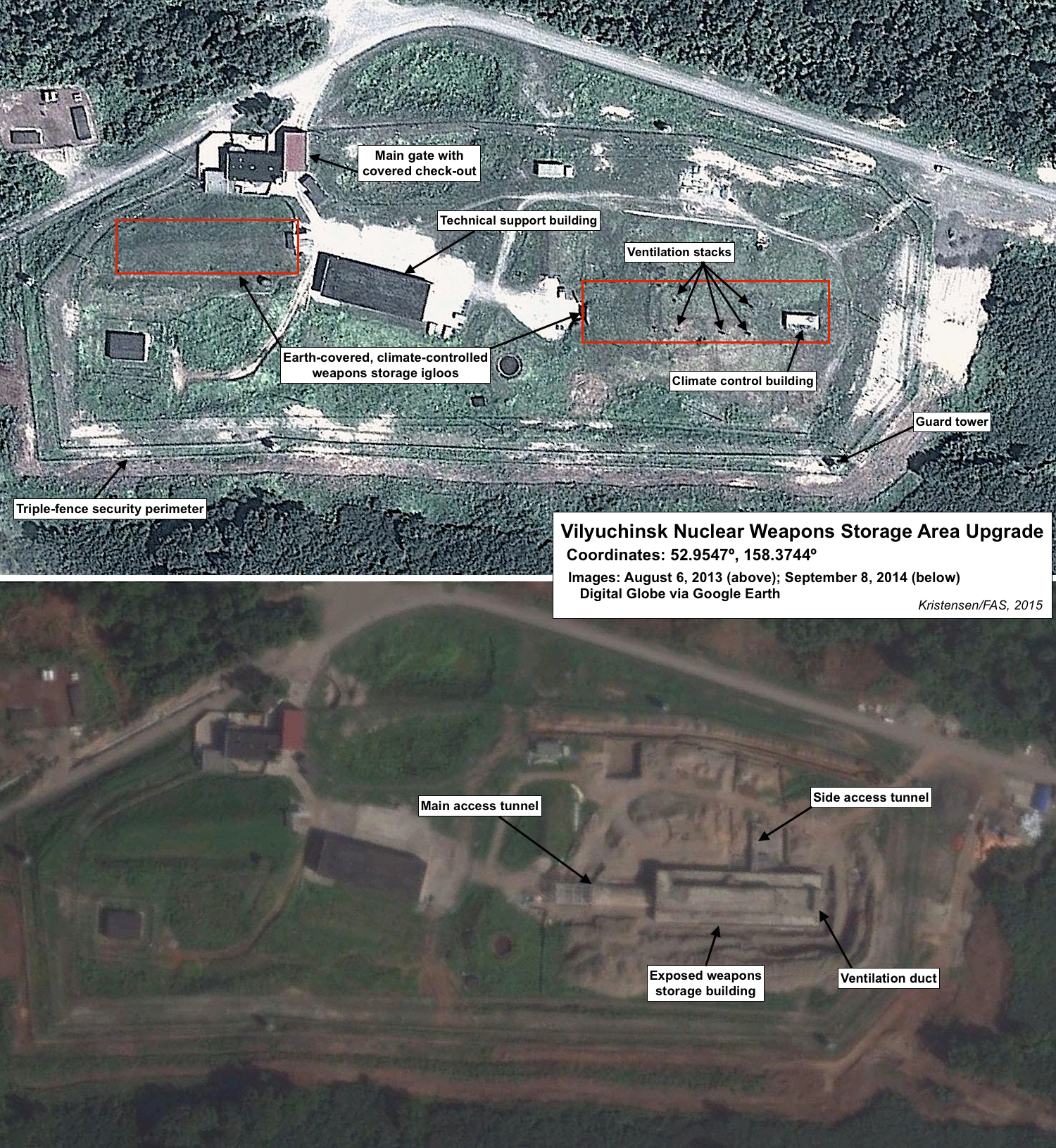
Russian Pacific Fleet Prepares For Arrival of New Missile Submarines
Later this fall (possibly this month) the first new Borei-class (sometimes spelled Borey) nuclear-powered ballistic missile submarine (SSBN) is scheduled to arrive at the Rybachiy submarine base near Petropavlovsk on the Kamchatka Peninsula.
[Update September 30, 2015: Captain First Rank Igor Dygalo, a spokesperson for the Russian Navy, announced that the Aleksander Nevsky (K-550) arrived at Rybachiy Submarine Base at 5 PM local time (5 AM GMT) on September 30, 2015.]
At least one more, possibly several, Borei SSBNs are expected to follow over the next few years to replace the remaining outdated Delta-III SSBNs currently operating in the Pacific.
The arrival of the Borei SSBNs marks the first significant upgrade of the Russian Pacific Fleet SSBN force in more than three decades.
In preparation for the arrival of the new submarines, satellite pictures show upgrades underway to submarine base piers, missile loading piers, and nuclear warhead storage facilities.

Several nuclear-related facilities near Petropavlovsk are being upgraded.
Upgrade of Rybachiy Submarine Base Pier
Similar to upgrades underway at the Yagelnaya Submarine Base to accommodate Borei-class SSBNs in the Northern Fleet on the Kola Peninsula, upgrades visible of submarine piers at Rybachiy Submarine Base are probably in preparation for the arrival of the first Borei SSBN – the Aleksandr Nevskiy (K-550) in the near future (see below).

Upgrades at Rybachiy submarine base.
Commercial satellite images from 2014 show a new large pier under construction. The pier includes six large pipes, probably for steam and water to maintain the submarines and their nuclear reactors while in port.
The image also shows two existing Delta III SSBNs, one with two missile tubes open and receiving service from a large crane. Other visible submarines include a nuclear-powered Oscar-II class guided missile submarine, a nuclear-powered Victor III attack submarine, and a diesel-powered Kilo-class submarine.
The arrival of the Borei-class in the Pacific has been delayed for more than a year because of developmental delays of the Bulava missile (SS-N-32) and the SSBN construction program. Russian Deputy Defence Minister Ruslan Tsalikov recently visited the base and promised that infrastructure and engineering work for the Borei-class SSBNs would be completed in time for the arrival of the Aleksander Nevsky (K-550). Predictions for arrival range from early- to late-September 2015.
Upgrade of Missile Depot Loading Pier
When not deployed onboard SSBNs, sea-launched ballistic missiles and their warheads are stored at the Vilyuchinsk missile deport and warhead storage site across the bay approximately 8 kilometers (5 miles) east-northwest of the Rybachiy submarine base. To receive and offload missiles and warheads, an SSBN will moor at one of two piers where a large floating crane is used to lift missiles into or out of the submarine’s 16 launch tubes.

Upgrades of Vilyuchinsk missile loading piers.
Satellite images show that a larger third pier is under construction possibly to accommodate the Borei SSBNs and the Bulava SLBM loadings (see above). This will also provide additional docking space for both submarines and surface ships that use the facility.

SS-N-18 handling at Vilyuchinsk missile loading pier.
The missile depot itself includes approximately 60 earth-covered bunkers (igloos) and a number of service facilities located inside a 2-kilometer (1.3- mile) long, multi-fenced facility covering an area of 2.7 square kilometer (half a square mile). The igloos have large front doors that allow SLBMs to be rolled in for horizontal storage inside the climate-controlled facilities (see image below).

Vilyuchinsk missile depot.
In addition to SLBMs for SSBNs, the depot probably also stores cruise missiles for attack submarines and surface ships. A supply ship will normally load the missiles at Vilyuchinsk and then deliver them to the attack submarine or surface ship back at their base piers. However, most of the Russian surface fleet in the Pacific is based at Vladivostok, some 2,200 kilometers (1,400 miles) to the southwest near North Korea, and has its own nuclear weapons storage sites.
Upgrade of Warhead Storage Site
When not mated with SLBMs onboard the SSBNs, nuclear warheads appear to be stored at a weapons storage facility north of the missile depot. The facility, which includes two earth-covered concrete storage bunkers, or igloos, inside a 430-meter (1,500-foot) long 170-meter (570-foot) wide triple-fenced area, is located on the northeastern slope of a small mountain next to a lake north of the missile depot. A third igloo outside the current perimeter probably used to store nuclear warheads in the past when more SSBNs were based at Rybachiy (see image below).

Vilyuchinsk nuclear weapons storage area.
Satellite images show that the nuclear weapons storage site is under major renovation. The work started sometime after August 2013. By September 2014, one of the two igloos inside the security perimeter had been completely exposed revealing an 80×25-meter (263×82-foot) underground structure. The structure has two access tunnels and climate control (see below).

Upgrade of Vilyuchinsk nuclear weapons storage area.
A later satellite image taken on November 1, 2014 reveals additional details of the storage facility. Rather than one large storage room, it appears to be made up of several rooms. One of the internal structures is about 37 meters (82 feet) long. A 30-meter (90 feet) long and 10-meter (30 feet) wide tunnel that connects the storage section with the main square of the site is being lengthened with new entry building. It is not possible to determine from the satellite images how deep the structure is but it appears to be at least 25 meters (see image below).

Upgrade of Vilyuchinsk nuclear weapons igloo.
The weapons storage facility is likely capable of storing several hundred nuclear warheads. Each Delta-III SSBN based at Rybachiy can carry 16 SLBMs with up to 48 warheads. In recent years the Pacific Fleet has included only 2-3 Delta IIIs with a total of 96-144 warheads, but there used be many more SSBNs operating from Rybachiy. Each new Borei-class SSBN is capable of carrying twice the number of warheads of a Delta III and so far 2-3 Borei SSBNs are expected to transfer to the Pacific over the next few years.
To arm the SLBMs loaded onto submarines at the missile-loading pier, the warheads are first loaded onto trucks at the warheads storage facility and then driven the 2.5 kilometers (1.6 miles) down the road to the entrance of the missile depot. During storage site renovation the warheads that are not onboard the SSBNs are probably stored in the second igloo inside the security perimeter or temporarily at the missile depot.
Implications and Recommendations
The expected arrival of the Borei SSBNs at the Rybachiy submarine base marks the first significant upgrade of the Russian Pacific Fleet SSBN force in more than three decades. The new submarines will have implications for strategic nuclear operations in the Pacific: they will be quieter and capable of carrying more nuclear warheads than the current class of Delta III submarines.
The Borei-class SSBN is significantly quieter than the Delta III and quieter than the Akula II-class attack submarine. A Delta III would probably have a hard time evading modern U.S. and Japanese anti-submarine forces but the Borei-class SSBN would be harder to detect. Even so, according to a chart published by the US Navy’s Office of Naval Intelligence, the Borei-class SSBN is not as quiet as the Severodvinsk-class (Yasen) attack submarine (see graph below).

Nuclear submarine noise levels. Credit: US Navy Office of Naval Intelligence.
The Borei-class SSBN is equipped with as many SLBMs (16) as the Delta III-class SSBN. But the SS-N-32 (Bulava) SLBM on the Borei can carry twice as many warheads (6) as the SS-N-18 SLBM on the Delta III and is also thought to be more accurate. How many Borei-class SSBNs will eventually operate from Rybachiy remains to be seen. After the arrival of Alexander Nevsky later this year, a second is expected to follow in 2016. A total of eight Borei-class SSBNs are planned for construction under the Russian 2015-2020 defense plan but more could be added later to eventually replace all Delta III and Delta IV SSBNs.
With its SSBN modernization program, Russia is following the examples of the United States and China, both of which have significantly modernized their SSBN forces operating in the Pacific region over the past decade and a half.
The United States added the Trident II D5 SLBM to its Pacific SSBN fleet in 2002-2007, replacing the less capable Trident I C4 first deployed in the region in 1982. The D5 has greater range and better accuracy than its predecessor and also carries the more powerful W88 warhead. Unlike the C4, the D5 has full target kill capability and has significantly increased the effectiveness of the U.S. nuclear posture in the Pacific. Today, about 60 percent of all U.S. SSBN patrols take place in the Pacific, compared with the Cold War when most patrols happened in the Atlantic. The US Navy has announced plans to build 12 new and improved SSBNs and there are already rumors that Russia may build 12 Borei SSBNs as well.
China, for its part, has launched four new Jin-class SSBNs designed to carry the new Julang-2 SLBM. The Julang-2 (JL-2) has longer range and greater accuracy than its predecessor, the JL-1 developed for the unsuccessful Xia-class SSBN.
Combined, the nuclear modernization programs (along with the general military build-up) in the Pacific are increasing the strategic importance of and military competition in the region. The Borei-class SSBNs at Rybachiy will sail on deterrent patrols into the Pacific officially to protect Russia but they will of course also be seen as threatening other countries. Rather than sailing far into the Pacific, the Boreis will most likely be deployed in so-called bastions near the Kamchatka Peninsula where Russian attack submarines will try to protect them against U.S. attack submarines – the most advanced of which are being deployed to the Pacific.
And so, the wheels of the nuclear arms race make another turn…
For more information, see: Russian Nuclear Forces 2015
This publication was made possible by a grant from the New Land Foundation and Ploughshares Fund. The statements made and views expressed are solely the responsibility of the author.
The FY2026 National Defense Authorization Act (NDAA) paints a picture of a Congress that is working to both protect and accelerate nuclear modernization programs while simultaneously lacking trust in the Pentagon and the Department of Energy to execute them.
While advanced Chinese language proficiency and cultural familiarity remain irreplaceable skills, they are neither necessary nor sufficient for successful open-source analysis on China’s nuclear forces.
Satellite imagery has long served as a tool for observing on-the-ground activity worldwide, and offers especially valuable insights into the operation, development, and physical features related to nuclear technology.
This report outlines a framework relying on “Cooperative Technical Means” for effective arms control verification based on remote sensing, avoiding on-site inspections but maintaining a level of transparency that allows for immediate detection of changes in nuclear posture or a significant build-up above agreed limits.